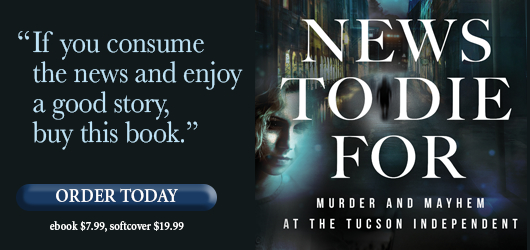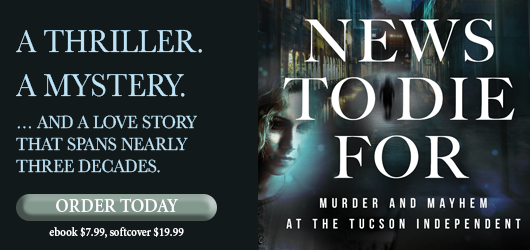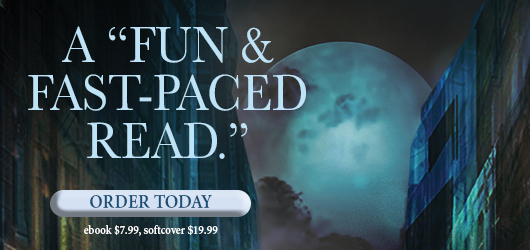An Interview with Robert Kimball, Author of News to Die For
In this digital, 24/7 news-cycle world, the idea that for most of the twentieth century, printed newspapers were delivered to front doorsteps before sunrise by entrepreneurial teenagers on bikes is almost too Norman Rockwell-Americana to believe. (Don’t get us started on the delivery of milk bottles.) But it’s true, and the daily miracle required by newsrooms to meet early morning press deadlines is the stuff of legend and fascinating to learn about.
Which is why we fell in love with Robert Kimball’s News to Die For, a riveting murder-mystery centered around The Tucson Independent, a fictitious daily newspaper in the American Southwest.
A former newspaper man himself, Kimball was gracious enough to answer a few burning questions we had about his book, predatory executives, and the artistry needed to create compelling characters.
The news business and journalism have taken quite a hit over the past four years: fake news, enemy of the people, et al. Was that realization on your mind as you worked on News to Die For?
Yes, and much more. When my editor, Betty Barr, and I were working on an early draft of the book, she said the book’s message was so timely that we should try and publish in the fall of 2018. She also said she was surprised about how much she had learned about the newspaper business by reading and editing the book.
As it turned out the book was published in February of 2020, more than one year later. I need not have worried that the book’s message was no longer of concern. The hit newspapers had been taking had only gotten worse as indicated nearly a year after News To Die For was published. In a January 13, 2021, Reuters News Service editorial, “Trust in governments, business chiefs and media is crumbling amid a perceived mis-handling by leaders of the coronavirus pandemic and a widespread feeling among ordinary citizens that they are being misled, a global survey has found.” COVID-19, for example, was not even in the news as I wrote News To Die For.
At an early age, Meghan became aware of the endemic sexism known to newsrooms, and then, had to fight off her boss in a scary sexual assault incident as an intern at her family’s newspaper. What is it about media organizations—we’re thinking about incidents at FOX News, NBC’s Today Show, The New Yorker—that breeds predatory, power hungry men, and why did you think it was important to capture that dynamic at The Tucson Independent in the book?
It’s not only media corporations that can be faced with endemic sexism issues. I worked twenty-five years at both small and large department store companies and seven years at a medium size family-owned media company. It’s been my observation that sexism exists to some extent in all, but endemic sexism, in my experience, tends to exist only in large corporations.
The difference is that in larger companies there are more employees all interacting with each other, sometimes in inappropriate ways. Power hungry executives tend to gravitate to larger corporations. If the chief executive officer (CEO) is a power hungry sexist, then it should be no surprise if a climate of endemic sexism develops.
What makes sexism so difficult for companies to deal with is that most of the time the power hungry sexist is also outstanding at getting results—sales, profits, stock performance. All too often, even after a complaint and or complaints are made, it’s the complainer(s) who get moved to another location or out the door. If it’s the CEO who is the problem, then the board of directors has to take action—usually the same board of directors who hired the CEO in the first place.
My overall goal for the novel was to show readers, in fictional scenes, what working at a newspaper can be like, including that your boss could be a sexist, a bully, or both, or how someone you know could be a murderer. I wanted to show that a woman like Meghan could attempt to and try to succeed in spite of sexism and family feuds.
Tucson’s front and center position in the American Southwest means it plays a leading role in some of the country’s most hot button issues: immigration, trade, drug trafficking, conservative politics, water rights, and more. Please talk about your decision to make it the setting of News to Die For?
I chose the fictional The Tucson Independent, a single location newspaper, as a way to reduce complexity. A media company with multiple locations would have additional layers of management. I wanted to keep the focus tight on one location. As to Tucson, I chose it not only because the Southwest plays a leading role in hot-button issues, but because I knew the area well. My wife, Terry, and I first came to the Southwest and to Tucson in the early 1960s on several vacations. We fell in love with both. We enjoyed the dry, clear weather. In 1974, I was transferred to Tucson as the opening store manager of the first Broadway department store in Tucson. In 1976, Terry and I purchased a forty-acre parcel in the Santa Rita Mountains, fifty miles south of Tucson and thirty miles north of the US-Mexico border. We had no more signed the deed than I was transferred to Broadway’s central office in east Los Angeles, 485 driving miles distant. In 1980, we retired to build, all by ourselves, our dream home. That could be another book.
I also wanted a setting for the novel that included a town large enough to support two daily newspapers, which Tucson did until recently. The Tucson Citizen ceased print publication May 16, 2009. Their online site closed on January 31, 2014. That left the Arizona Daily Star the only daily in Tucson.
Kerry, Meghan’s almost but not completely evil stepmother, is a poisonous influence on everything and everyone she touches, from the sadistic manipulation of her stepchildren, to her corrupt bookkeeping role at The Tucson Independent to the way she toys with the detectives seeking to question her in the killing of her husband. In fact, she might qualify as the central, orbital, controlling figure in the book. Tell us about how her role evolved in your mind as you worked on the novel?
A villain is often a central controlling figure in fiction as well as in life. Think Cinderella’s mother and Hitler. A villain is utterly lacking in principal. In life as well as in fiction, it takes a hero or heroes to fight to eliminate a villain. I have witnessed and tangled with a few villains in the business world. Kerry is worse than all of them put together. It was my way to give Meghan an almost impossible problem to overcome. Just as in a movie, most cringe when the villain appears. I wanted readers to cheer when Meghan was in the scene.
One of the novel’s innovative aspects is The Tucson Independent editorial columns you drop in occasionally, serving to provide a bit more background to events taking place. What inspired you in that decision?
In the editing process several of the manuscript readers and my editor said some chapters were too slow and in others an issue was overdone, or worse yet, was boring. As a former editor, my first thought was to cut and then cut some more. I also was concerned that the book was becoming too long. In most cases I cut, however, in one problem chapter that I wanted to save, I tried rewriting part of it as a newspaper column. This placed a much-needed break in the chapter. It was not only a visual break (the editorial copy was surrounded by more white space than was true for the chapter’s copy, and the editorial column included a headline and a by-line).
It was also a change of speaker and point of view. It was like in a real newspaper where you could say things on the editorial and opinion pages that you couldn’t say in a news story. At least that was the way it was supposed to work. The idea was that the reader should understand that when reading a news story, it was based on fact. When reading an editorial or an opinion piece, those items were the opinion of the writer not necessarily that of the paper. Today, in social media anything goes, including fake news. The News To Die For readers and editor liked the inserting of a column approach so much that they all said I should do more of it. I did it gladly.
You have used a wide range of characters—more than in most novels. Where do you get your character ideas and how do you develop them?
I have always hated books with too many characters, such as complex British mysteries. The ones where I had to write down each character as they appeared as a way to keep track of them all. I vowed I would never write such a book. When Betty Barr showed me the list of characters for my book, I couldn’t believe it. I had more characters than I had complained about. In my defense, I think the trick to keep readers from giving up due to too many characters is to always introduce each character as they appear with just enough interesting characteristics that the reader will be able to remember each.
Several years ago, we were having dinner with some friends of ours, Don and Jay Irving. Don is a retired art school director and dean. When I told him I was writing a novel, he said he had done mountains of writing over the years—all non-fiction: a book, Sculpture: Materials and Processes, as well as a master’s degree thesis, and another for his EDD, doctor of education.
Don asked, “I can’t imagine how I could just make up a fictional character. How do you do it?” It took me a minute to answer. While I was thinking what to say, our dinner was served and the moment was lost. Here is what I should have told Don. Some authors compile long lists of features and characteristics for each character, such as height, weight, hair color, eye color, age, sexual orientation, highest educational degree attained, shoe size, etc. My approach for each character was to come up with just a few distinguishing features, features that differentiate him from other characters in the novel and let the readers’ imaginations fill in the blanks.
Let’s say I was introducing a new character for the first time in a novel I was writing. In this scene, Bill Jones is meeting a woman for the first time.
Bill Jones stood first on one foot then the other trying to figure out what to say. He took a red bandana from his 501 Levi’s’ back pocket and wiped his brow.
“Hi, I’m Bill,“ he said as he reached out as if to shake her hand, but stopped, hand midair while figuring out what to do with the soggy bandana. He threw it to the pavement and crushed it like a cigarette butt with with the heel of his cowboy boot.
“What’s your name, ma’am?“ he asked.
In this example, I have challenged the reader to fill in the blanks about Bill. What can the reader learn about him from this scene? He’s probably a cowhand or at least dresses like one. He’s nervous, first standing on one foot then the other. He doesn’t know what to do with his soggy bandanna. He doesn’t know what to say other than “what’s your name, ma’am?” I think the reader will remember Bill better this way than if I had said, Bill is tall, of medium build, with blue eyes and blond hair. He is twenty years old.

What’s next for you and your talented pen?
A sequel, I think. Several of my readers have asked me when the sequel will be out. I’m aware that sequels are often not as good as the original. I think it’s because the writer used all the good material in the original. I may have done that but I think there’s enough interest in the fate of newspapers and the media. And Meghan has a long life still to live, or does she?
Barbara Hodge


